People Call This Thousand-Year-Old Fortress In Sri Lanka The 'Eighth Wonder In The World'
It kinda looks like Pride Rock from Lion King right?
Located in the Central Province of Sri Lanka is a stone fortress that is more than a thousand years old
The ancient stone fortress, called Sigiriya, was built by King Kasyapa of Sri Lanka back in the fifth century. The fortress got its name (which means "lion rock") from the shape of its structure, which looks like a giant lion from far.
It also looks like a place where we can totally do this:
Fearing an invasion, the king chose the secure Sigiriya as a new capital and built his palace on top of the rock. After King Kasyapa's death, the fortress was converted into a Buddhist monastery till the 14th century.
Some have called it the eighth wonder of the world
Sigiriya disappeared from the records after the 17th century, when it was used as an outpost. The fortress was then rediscovered by a British military officer in 1831, and archeological works started in the 1890s.
What archaeologists found was a network of palaces and gardens, some of the most complex structures known to mankind. The buildings on top of the rock are arranged in an elaborate and precise manner, which presented this site as one of the best, if not the most important, urban planning examples of the first millennium.
It is now listed as a UNESCO World Heritage Site.
1. The Water Gardens
Sigiriya has one of the world's oldest landscaped garden, and the water gardens are just one a part of the overall garden.
During its heyday, one can find over 100 bathing pools, ponds, and fountains. Some of them have beautiful pavilions built nearby, so members of the royal household can use these for leisure purposes.
Situated at the western side of the fortress, water is brought in to the gardens through a sophisticated ancient hydraulic system. This includes a web of canals, dams, and underground water pumps. The fountains were arranged around the compound in such a way to keep the place cooling.
The Water Gardens are comparable to those of ancient Rome and Middle East in terms of aesthetics and technology.
2. The Mirror Wall
This is a 3m-tall wall that is coated with special plaster made from fine lime, egg whites, and honey. It is also buffed and polished with beeswax.
It's said that this wall used to be so polished, the king and his guests could see their own reflections and that of the paintings on the wall behind them. Sadly, the once white wall is now orange after centuries of neglect.
The wall is also known for having the famous Sigiriya Graffiti. If you look closely, you can find scribbles in Sinhalese, Sanskrit, and Tamil scripts on the wall. These are poems written by visitors between the sixth and 14th century about the painted women they saw reflected on the Mirror Wall.
The Graffiti is regarded as precious findings as they show the development of the Sinhalese language, as well as reflective of the literature trend from that time.
3. The frescoes
Also located on the western side of the fortress is a gallery of colourful frescoes, painted almost 1,600 years ago. The gallery features more than 500 beautiful women wearing bright-coloured clothes and splendid jewellery, all painted in the unique Sri Lankan ancient Sinhala style.
Scholars have different theories regarding the identities of the painted women: some say that they are heavenly beings, while others think that they could be the king's wives.
The frescoes used to stretch from one end of the stone fortress to the other end back when the royal household was still living there. However, due to weather conditions and neglect, only a small portion of the frescoes remain today.
4. The Lion Staircase
To get to the top of Sigiriya, you'll need to climb the Lion Staircase. The two huge paws on each side of the staircase are the only things that remain from what used to be a huge lion statue.
What makes this flight of stairs so impressive is that it's all carved out from a rock. It's even more amazing when this, along with its many palaces and gardens, were built in just seven years!
It's about a 200m-climb to the top, so make sure you have enough water with you before you attempt to climb to the top. The original stone steps have since been replaced with newly constructed iron steps for easier tourist access.
The best time to visit Sigiriya is between January to March
Sigiriya and other parts of Sri Lanka generally experience good weather during these months. The weather is not too hot and you'll have plenty of sunshine to go sightseeing without worrying if it will rain. However, if you're travelling on a budget and don't mind the occasional shower, the months between July and September are good for travelling around Sri Lanka and visiting Sigiriya too.
The stone fortress is opened daily from 7am till 5:30pm. Entrance fee is USD30 (about RM128.28).
Accommodation
You can find budget and luxury accommodation near Sigiriya, ranging from about RM180 to RM1,250 per night for a double room.
One of the top rated hotels nearby is Jetwing Vil Uyana, which is an eco-friendly resort in a natural reservoir. You get to stay in a traditional house on stilts in a paddy field, which cost about RM789 per night.
Equally as cosy but more wallet-friendly is Flower Garden Eco Village, a simple resort which is less than four kilometres away from the World Heritage Site. A double room here is about RM180 per night.
AirAsia flies to Colombo, Sri Lanka 10 times a week
There's a direct flight from klia2 to the capital of Sri Lanka, you can check the latest fare here. You can opt to spend some time in Colombo to do some sightseeing before heading to Sigiriya.
Malaysians will require a visa to travel to Sri Lanka. You can apply for an Electronic Travel Authorisation (ETA), equivalent to a 30-day short visit visa, online through the Sri Lankan Immigration and Emigration website.
The ancient stone fortress is 166km away from Colombo and there are a few ways to get there:
Train
The nearest train station to Sigiriya is Habanara, which is five hours away from the Colombo station. A ticket can cost between LRK240-620 (about RM6.68-17.26).
Bus
This is the cheapest transportation to Sigiriya, costing about LKR190 (about RM5.29). The journey is four hours long but it may not be the most comfortable option.
Taxi or chartered vehicle
Most people would recommend this option. It's not as expensive as the domestic flight from Colombo, and it doesn't take too long. You can get a taxi or chartered car there at about LKR4,000 (about RM111.33).















